Welcome to Fusion City, USA
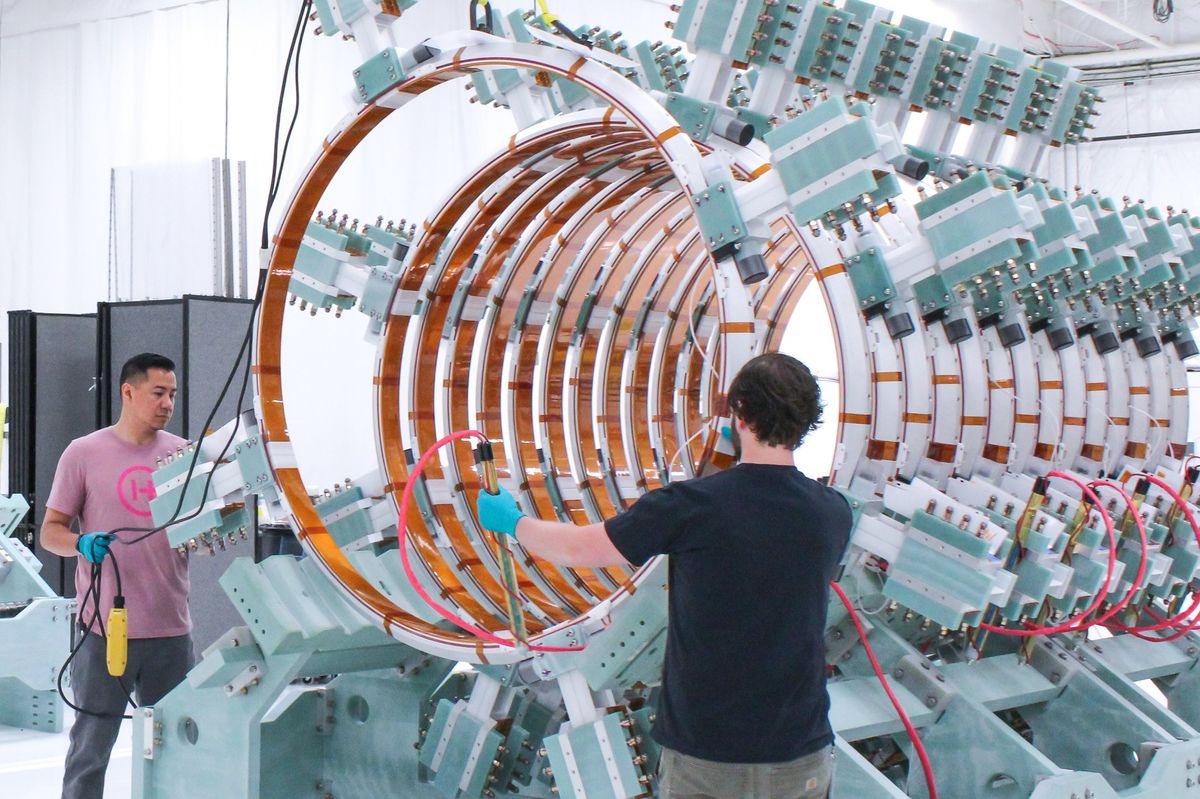
The future of carbon-free energy smells like teriyaki and sounds like a low-flying 737. A sleepy strip mall beside Boeing's sprawling campus in Everett, WA isn't necessarily where you'd expect to find technology promising to harness the power of the sun, release humanity from the grip of fossil fuels, and unlock an estimated US $40 trillion market.
But here, and in an even more anonymous office park nearby, startup Zap Energy is trialing a prototype reactor that is already producing high-energy neutrons from nuclear fusion-if not yet enough to send power back into the grid.
The unglamorous location is no accident, says Derek Sutherland, Zap's senior research scientist. If you squint hard enough, building a fusion system is not that different from building an airplane," he tells Spectrum on a visit in June. It requires a little bit of retooling and retraining but you can transfer a lot of those skills."
Zap isn't the only fusion company fishing in aviation's talent pool. Less than two miles away, Helion Energy has its own facility, purchased from a Boeing contractor and housing its own operational fusion prototype built in part by aerospace veterans. The two startups represent a unique concentration of fusion expertise and funding, and epitomize a new confidence that fusion power is now a solvable engineering challenge rather than an eternally elusive scientific puzzle.
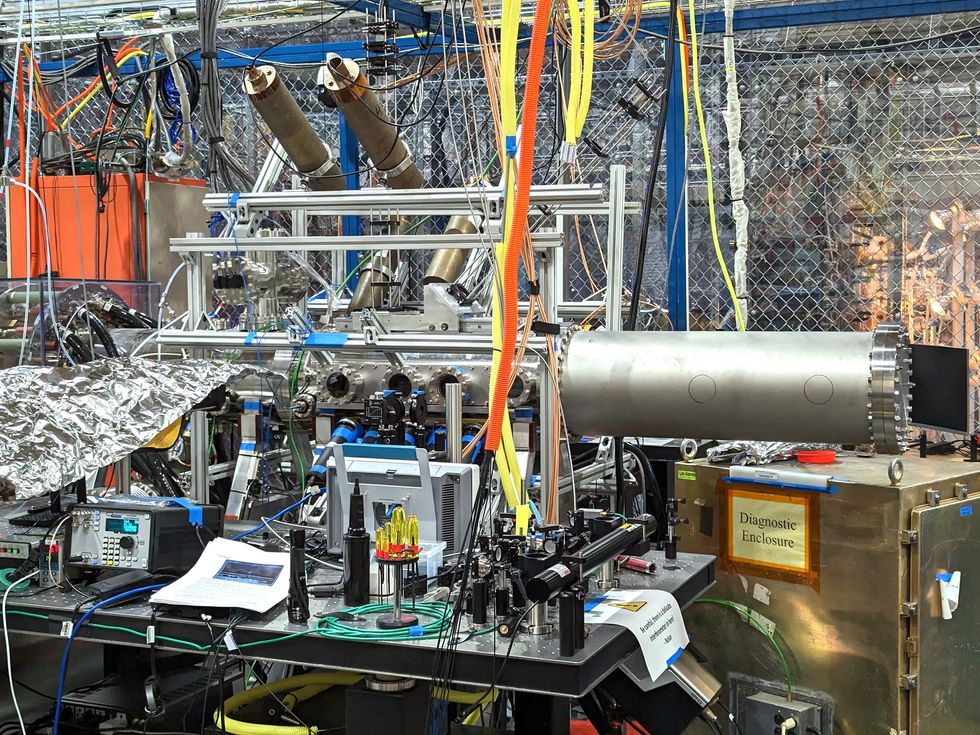 Zap Energy has already conducted tens of thousands of fusion pulse tests in its early prototype reactor.Mark Harris
Zap Energy has already conducted tens of thousands of fusion pulse tests in its early prototype reactor.Mark Harris
Zap's Fuze-Q prototype sits in an odor-free air-conditioned room and makes only a barely-audible tick when it operates. Since going active last summer, the office-desk-size device has housed thousands of fusion reactions, each generating reams of data as Zap gradually ramps it up towards the temperatures, plasma densities, and reaction times necessary to generate more power than it consumes. The entire fusion process is about as dramatic as flipping a light switch, and Sutherland walks us right up to the small reactor shortly afterwards one such operation.
This isn't some scaled-down experimental toy. Zap's commercial fusion reactor, intended to reliably produce enough power for 30,000 homes-day and night, year-round-will be exactly the same size as the prototype, with the addition of a liquid-metal blanket," heat exchangers, and steam turbines to turn its energetic neutrons into electricity. The core reactor will be shorter than a Mini Cooper.
If this doesn't match your mental image of fusion power, you're probably picturing the city-block-size ITER megaproject currently taking shape in southern France. By the time that long-delayed publicly-funded reactor goes live, possibly not until 2029, it will be 30 meters tall and weigh more than 18,000 Mini Coopers. It will also have cost China, the European Union, the United States and other partners over US $22 billion.
The two main drivers of cost are complexity and size," says Sutherland. Zap excels at reducing both of those as much as possible because the system has no cryogenics, no superconducting coils, no auxiliary heating, and no magnets."
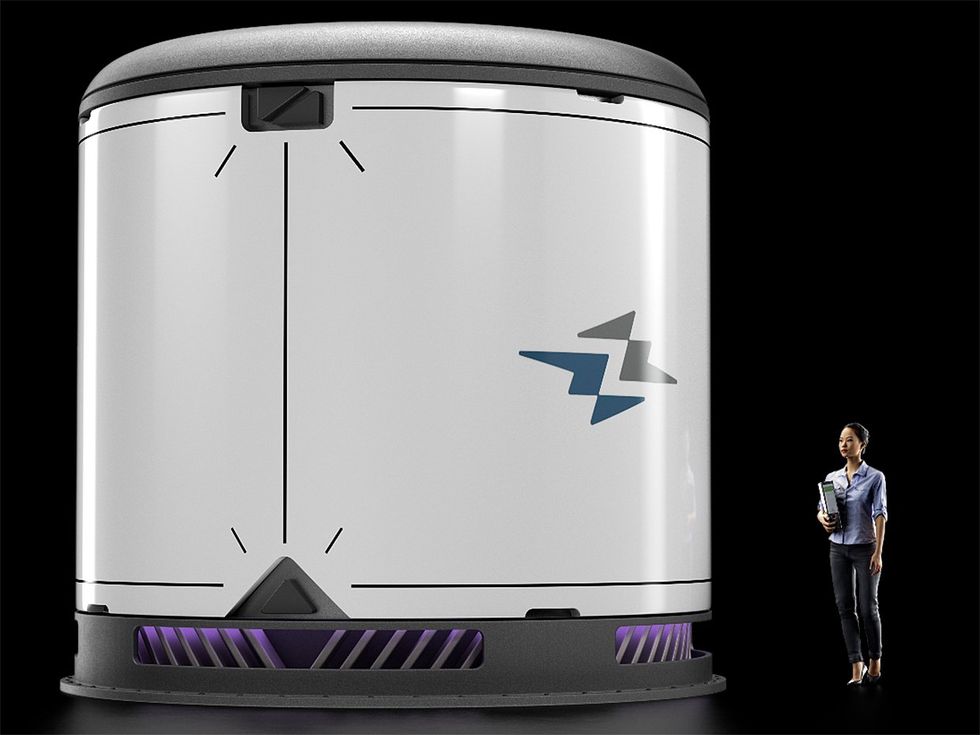 Zap Energy is developing an approach to fusion called a sheared-flow-stabilized Z pinch, which produces fusion reactions in small bursts rather than a continuous stream.Zap Energy
Zap Energy is developing an approach to fusion called a sheared-flow-stabilized Z pinch, which produces fusion reactions in small bursts rather than a continuous stream.Zap Energy
Zap and Helion are leading the charge for what is often called alternative fusion"-the belief that gargantuan systems are neither necessary nor desirable in the search for practical fusion power. To understand why, it's helpful to have a quick refresher on nuclear physics.
Fusing together ions of some light elements in a gaseous plasma can release a bunch of energy if-and it's a big if-you can overcome their mutual electrostatic repulsion. That means increasing the ions' kinetic energy until they're moving fast enough (i.e. they're hot enough) to collide and fuse. ITER's reactor is a traditional tokamak design that aims to ignite a burning plasma ten times hotter than the Sun, in a giant hollow donut 20 meters wide. The larger the donut, the more power is produced; thus ITER's gargantuan size.
But the faster and hotter the ions, the harder they are to confine. Zap compares stabilizing plasma to holding jelly with rubber bands, and keeping ITER's fusion reaction going will require an immense battery of cryogenically-cooled superconducting magnets.
Zap and Helion's bet is that instead of trying to coax a continuous fusion reaction to life, it will be easier to string together short pulses of fusion activity. Zap's pulses start with a puff of deuterium (an isotope of hydrogen) plasma at one end of a meter-long vacuum tube, at the center of which is an electrode. The plasma is accelerated down the tube until it reaches the tapered end of the electrode, at which point magnetic forces pinch it into a tight column, with different layers flowing at different speeds. This sheared flow keeps the plasma stable and generating high energy neutrons until it collapses. At the moment, that happens after about ten microseconds. In a commercial device, it will need to last closer to a hundred, and the fuel will include a short-lived, expensive, and hard-to-find isotope of hydrogen called tritium.
There will be a few more devices between Fuze-Q and a pilot plant," says Sutherland. We think five to 10 years is realistic. But we also think that maybe it doesn't do the public any favors to hear us promise you a plant in five years."
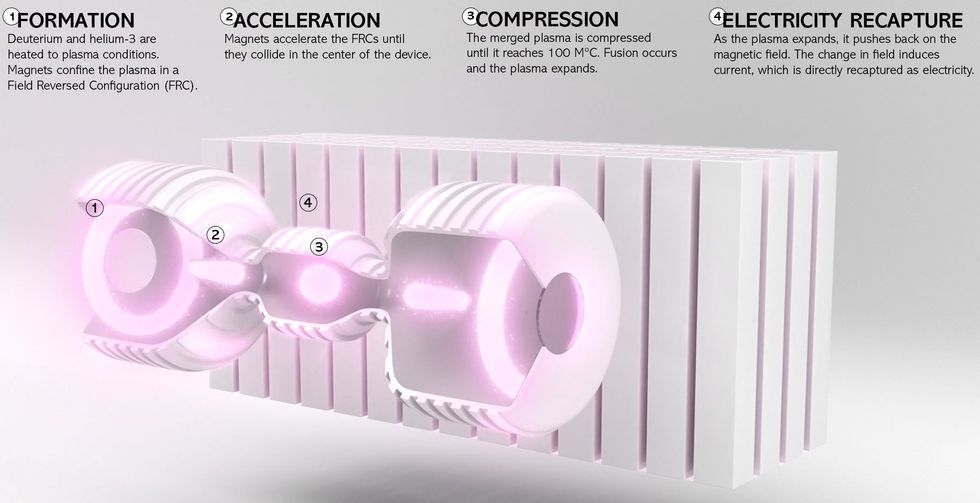 Helion's prototype reactor requires four distinct stages for fusion that ultimately lead to producing electricity through induced current changes.Helion Energy
Helion's prototype reactor requires four distinct stages for fusion that ultimately lead to producing electricity through induced current changes.Helion Energy
Just up the road in Everett, Helion has gone one step further than promising a pilot reactor. It has already sold 50 megawatts of power to Microsoft, for delivery in 2028. This confidence is reflected in Helion's modern, securely-gated campus, home to three cavernous warehouses and an auxiliary site crawling with earth movers. Many of Helion's 160 staff work in its largest 150,000 square feet warehouse, where components for its seventh and final prototype Polaris are now being assembled.
My visit starts in Helion's capacitor kitchen," so-called for the various processes involving in coating, testing, and baking the thousands of oil-filled capacitors Polaris will need. Huge banks of capacitors are the only way to quickly deliver the massive pulses of energy necessary to kick-start both Zap's and Helion's fusion reactions. Zap's capacitor bank will store 1.5 megajoules of energy-about a third of the energy released from a kilo of TNT. Helion's will store a staggering 50 MJ, requiring 150 shipping containers full of capacitors, synchronized with semiconductor switches to discharge in less a millisecond.
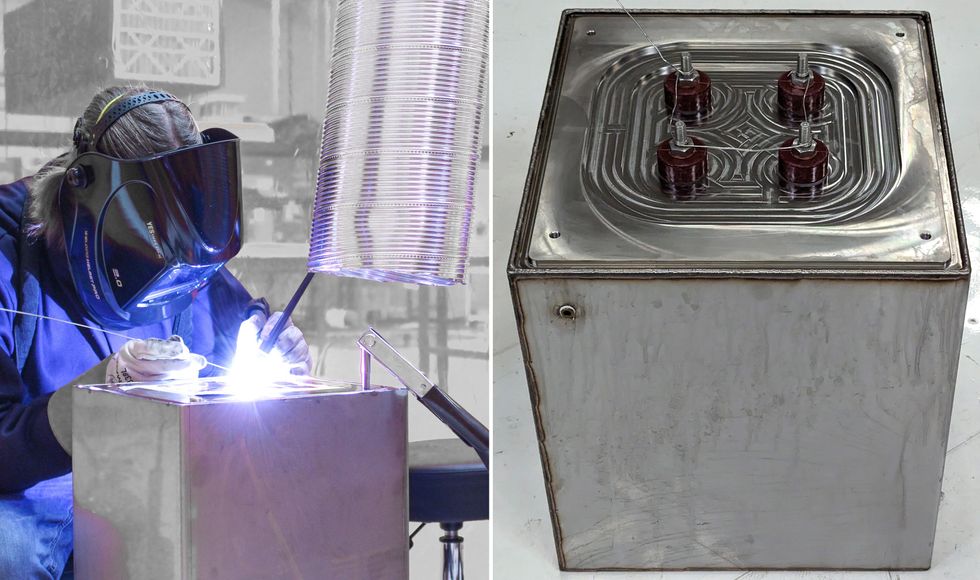 A fusion technician welds an in-house manufactured capacitor for Helion's Polaris generator. The latest prototype will need thousands of completed capacitors like this.Left: Helion Energy; Right: Mark Harris
A fusion technician welds an in-house manufactured capacitor for Helion's Polaris generator. The latest prototype will need thousands of completed capacitors like this.Left: Helion Energy; Right: Mark Harris
When complete, Helion's reactor will be bigger than Zap's, about two meters tall and 12 meters long. Its initial jolt powers a series of electromagnets at either end of Polaris that form and accelerate clouds of plasma towards their common center. It is at the reactor's narrowest point-subject to the strongest magnetic field-that fusion briefly occurs. Like Zap's design, Helion's commercial reactor is intended to pulse about once per second and generate 50 MW. But there are some big differences.
For a start, Helion will fuse deuterium with helium-3, an ultra-rare and extremely expensive isotope of helium, in a reaction that produces relatively few neutrons. That isn't a problem for Helion because it doesn't need neutrons to boil water but instead produces electricity directly from the fusion reaction. In Polaris, each fusion pulse should cause the plasma to expand, increasing its magnetic flux and inducing electric current in the magnetic coils that ultimately flows back to the capacitors.
The National Ignition Facility experiment last year proved key science in igniting a plasma for the first time," says David Kirtley, Helion's founder and CEO. But in the process they threw away 99.9 percent of the input energy. We have proven our system can recover 95 percent, so we only lose about 5 percent of the energy that we put into the fuel. That means we have to do that much less fusion to reach net gain."
Relatively few fusion start-ups are planning to use helium-3 as a fuel, which is so scarce that some experts have even suggested mining it on the moon. Polaris, however, should be able to produce its own helium-3 from deuterium, and Helion claims that it has already generated (although not separated) a small amount.
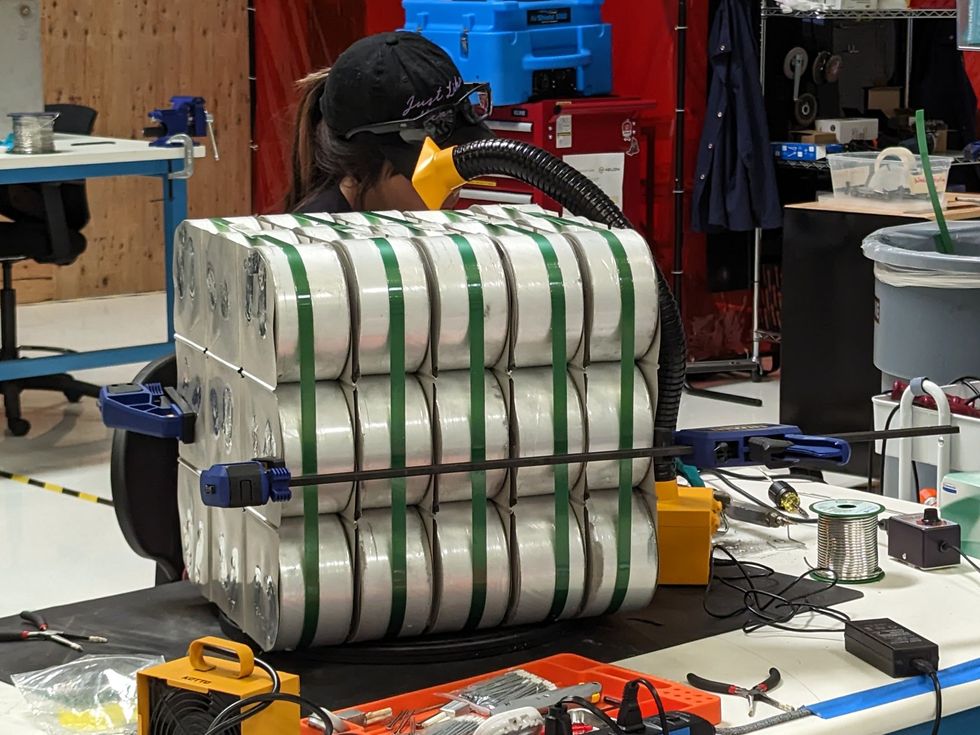 Workers construct banks of capacitors at Helion Energy. The startup's prototype reactor will need enough capacitors to store 50 megajoules of energy. Helion Energy
Workers construct banks of capacitors at Helion Energy. The startup's prototype reactor will need enough capacitors to store 50 megajoules of energy. Helion Energy
With just 100 capacitors and one of the formation magnet coils built so far, Kirtley's plan is to assemble Polaris by January 2024. Helion will then gradually increase power and compression through the year. If all the scaling holds and everything works the way we expect, we should be able to recover enough electromagnetic energy from the fusion system to recharge those banks plus a little bit extra," he says. And that little bit extra is net electricity."
But even Polaris is unlikely to produce any leftover power once the energy demands of cooling and switching systems are factored in. That will fall to Polaris's successor, a pilot fusion reactor aiming to fulfill Microsoft's power contract sometime in 2028. While the location of that has yet to determined, it's likely to remain in the state.
Washington in particular has been very friendly to fusion," says Kirtley. You have the University of Washington that's done fusion since the 1970s, you have the industrial expertise and a huge aerospace industry to draw on, and at the government level, they've been really thoughtful about new technologies."
That matters because fusion research, with no risk of runway chain reactions and producing vastly less radioactive waste, is being conducted under existing regulations by individual states, rather than the federal Nuclear Regulatory Commission.
We're in a period of transition from science towards engineering, but we still have plasma physicists on staff and we will for quite some time," says Zap's Sutherland. We're trying to decarbonize the energy base load for the entire planet. If Zap works, it will change the world."